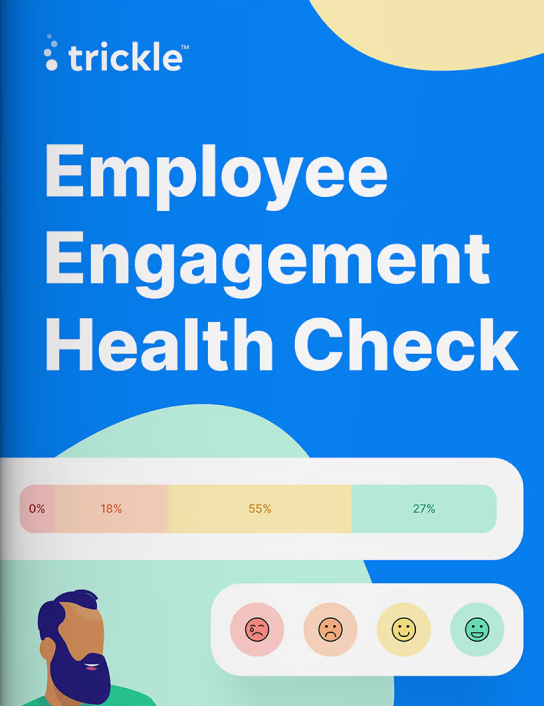How well does your company engage its employees?
Take your health check and find out.


Many organisations are becoming confused with the difference between employee engagement and employee experience. This can be a costly mistake, resulting in unhappy employees, who are less productive and less likely to become an advocate for their employer.
As the world gradually returns to work in an office environment, albeit with some differences, focusing on employee experience is vital to ensuring that all employees are adequately supported post what would be, for some, a traumatic experience.
In this article, we’ll explain the difference between employee experience and employee engagement and what employers can do to make sure that their staff experience is great.
According to Gallup – “Employee engagement includes emotional and social needs, like doing work that you are good at and connecting your work with a higher purpose.”
On the other hand, employee experience is the journey that an employee takes throughout their time working in an organisation. This starts from the recruitment process all the way through to the exit process.
Think of employee engagement as one part of the overall employee experience. The better the employee’s experience, the more engaged with their job and their employers that they are likely to be. As a result, they are more likely to be productive and become an advocate for their employers, which will make recruiting their colleagues, as well as their eventual replacements (all good things must come to an end) easier.
Current or previous employees are the best source of employer marketing.
Some employers have made the mistake of focusing solely on engagement, but this isn’t a good strategy. Think of it as focusing on getting a child to like playing with a certain toy without thinking about whether or not they enjoy the experience of playing with that toy.
Employee experience is everything for both the success of employers and employees. Employee engagement is included in this. Once the experience is sorted, the engagement will follow, as will productivity and advocacy after that.
The war for top talent is fiercer than ever. Prospective employees have a wider range of choice, to the point where salary isn’t always enough to get people to come and work for you or stay with you.
Human Resources is no longer just an admin offshoot department. For many organisations, it’s fast becoming an integral part of the overall business strategy — which seems obvious now when you think about it. For any organisation to be successful, it needs great people to feel great about working for it. You can throw all the marketing, technology and legalese at a company, but if it doesn’t provide a positive experience for the people that work there, it’s pointless.
The pandemic caused a sharp increase in remote working, with data from the ONS stating that 25.9% of people in the UK worked from home in 2020, up from just 12.4% in 2019. London, interestingly, had the highest concentration of remote working in the UK with 48%.
It may not sound like a lot overall, but the combination of the pandemic and advancements in technology such as Slack, Zoom and Trickle seems to have triggered a shift in thinking. More employees are at least considering the idea of working remotely for a couple of days a week, if not the entire week. Employers have to respond to this change in attitudes by enabling flexible working.
However, as it often is in many aspects of life, solving one problem creates another. How do employers create a positive employee experience if some or even all of your employees are working remotely?
There are a number of barriers to productivity and a positive employee experience when a number of people work from home or an alternative workspace such as a coworking office.
The Harvard Business Review outlines a few key issues:
Distractions – There may be distractions at work too, e.g. other colleagues having impromptu conversations, people randomly asking for help with a task, the noise of other conversations etc. However, working from home or an external office also has distractions such as digital devices, phone calls, food, family members etc. This can be amplified if an employee doesn’t have a suitable designated workspace such as a desk with a second screen in a quiet room.
Social isolation – As much as we’re all connected to each other via numerous devices and apps, it’s still not a substitute for in-person interactions. This can be a particularly poignant issue for the more extroverted personality types who feed off the energy of other people in person.
Lack of face-to-face supervision – This particular issue is more geared towards employees feeling that their managers have an ‘out of sight, out of mind’ attitude to their issues. Because there isn’t a physical office to speak of, it can be more difficult for managers to supervise employees, at least initially.
Lack of access to information – When all the communication is digital, it’s sometimes trickier to get information quickly. In a physical office, a person can simply walk up to their colleague and ask them a question, have a chat, etc. Whereas, remotely, the boundaries are a little more defined. For example, there may be a need to book time in someone’s calendar to solve something that would have taken a 5-minute unplanned conversation.
Also, responses to messages may take longer as there isn’t physical pressure to respond.
There are a few ways to solve these aforementioned problems.
Regular digital check-ins – This can help to deal with the lack of face-to-face supervision. Weekly check-ins give employees a chance to raise any issues that they may have or make suggestions where things could improve.
Invest in adequate technology – Tools such as Slack and Zoom help people communicate better. Email is still useful, but it’s no longer adequate to deal with the wide variety of conversations we now have online.
Outline clear communication rules – Once the tools are implemented, there needs to be clarity on how they are used. For example, a company may use Zoom for client calls but Slack for internal calls. Another rule may be tagging people in Slack channels so that they will be notified when they need to read something.
Provide places for social interaction – Just because you’re not in an office doesn’t mean you can’t socialise. Managers should schedule time for employees to get to know each other on a more personal level. This could be a weekly group call where everyone speaks about things not related to work.
Our platform empowers your team to work well from wherever they are in the world. Solving problems collaboratively, giving feedback and celebrating wins is now possible, even though the ‘office’ is virtual. Happier employees and more productivity will happen as a result.
Click the link below to get your free demo today